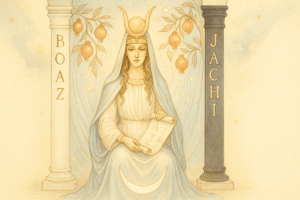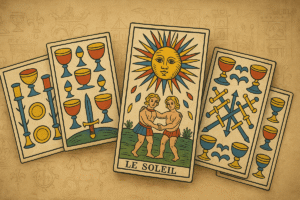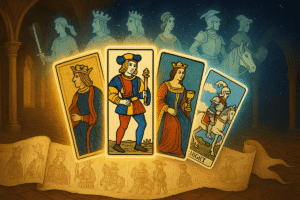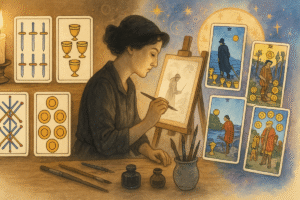Table of Contents
When you first encounter the High Priestess card in a tarot deck, those two pillars flanking her immediately catch your attention. They stand there, solid and mysterious, often labeled with the letters B and J. Perhaps you’ve wondered what they mean, or why they keep appearing in different cards throughout the deck. I know I did when I was learning tarot, and honestly, the more I explored them, the more fascinating they became.
These pillars aren’t just decorative elements. They carry centuries of symbolic weight, drawing from ancient temple architecture, mystical traditions, and the human need to understand opposing forces in our lives. Let me walk you through what I’ve learned about these enigmatic structures and what they might invite you to consider in your own spiritual practice.
The Biblical Foundation of the Pillars
The story of these pillars begins in the Hebrew Bible, specifically in the First Book of Kings. When King Solomon constructed his temple in Jerusalem, two massive bronze pillars were erected at the entrance. The right pillar was named Jachin, and the left pillar was named Boaz. Different translations and scholarly interpretations have given us various meanings for these names. Jachin is often understood as “he establishes” or “he will establish,” while Boaz translates roughly to “in strength” or “in him is strength.”
Now, the interesting thing is that these weren’t load bearing pillars supporting the roof. They stood independently at the temple entrance, serving what seems to have been a purely symbolic function. Some historians suggest they were meant to evoke the pillars of fire and cloud that guided the Israelites through the wilderness. Others think they represented concepts like stability and divine presence.
What strikes me most about this biblical origin is how it establishes the pillars as markers of a threshold. They didn’t support the building; they announced it. They said, “This is a sacred space you’re about to enter.” That threshold quality becomes incredibly important when we look at how tarot uses this imagery.
The Pillars in Tarot Imagery
The most prominent appearance of the two pillars in tarot is on the High Priestess card. She sits between them, a serene figure holding ancient wisdom. The pillars here are typically shown in contrasting colors, often black and white, and sometimes bear those mysterious letters B and J that connect them back to their Solomonic origins.
But the High Priestess isn’t the only card featuring this motif. Look at the Hierophant and you’ll often see similar pillars framing the religious figure. Even in some versions of Justice, pillars appear in the background. The repetition across different cards suggests something deliberate, a visual language the tarot is trying to speak.
In the Rider Waite Smith deck, which is probably the most widely recognized tarot system today, the High Priestess sits with a pomegranate covered veil behind her, stretched between those two pillars. The left pillar is black with the letter B, the right is white with the letter J. This stark contrast immediately signals duality to anyone viewing the card.
I think what makes the pillars so powerful in tarot imagery is their stillness. Everything else in the cards might show movement or action, but the pillars just stand there. They’re constants. They’re the framework within which everything else happens.
Duality and Balance
Perhaps the most accessible meaning of the two pillars relates to duality. The black and white coloring isn’t subtle. It speaks directly to the concept of opposing forces that exist throughout existence. Light and dark. Masculine and feminine. Action and receptivity. Conscious and unconscious. The list goes on.
But here’s where it gets interesting, and maybe a bit paradoxical. The pillars represent opposites, yes, but they also suggest that these opposites need each other. Neither pillar stands alone in the imagery. They create a space between them, and that space is where the real magic happens. The High Priestess doesn’t sit on one pillar or the other. She occupies the middle ground.
This invites you to consider where in your life you might be clinging too hard to one extreme. Are you all logic and no intuition? All giving and no receiving? The pillars ask you to look at both sides. Not to eliminate one in favor of the other, but to recognize that both exist and both have their place.
Some tarot readers interpret Boaz as representing the feminine principle and Jachin as the masculine. Others reverse this association or connect them to different esoteric concepts entirely. I’ve seen interpretations linking them to severity and mercy, form and force, even death and birth. The specific associations matter less, perhaps, than the fundamental recognition of polarity itself.
When you’re working with cards featuring the pillars, you might ask yourself questions like these. What opposing forces am I navigating right now? Where do I need to find balance? Am I denying one aspect of a situation while overemphasizing another?
Gateways and Thresholds
Remember how I mentioned the pillars at Solomon’s Temple marked an entrance? That threshold symbolism carries through strongly in tarot. The pillars create a doorway, a passage from one state of being to another.
The High Priestess guards this threshold. She sits before the veil that conceals deeper mysteries. To move past her, between those pillars, represents a journey into hidden knowledge or unconscious realms. It’s not a casual stroll. It’s a significant crossing.
This gateway symbolism connects to initiatory traditions in many mystical schools. Passing between pillars has long been used in ceremonial contexts to represent moving from profane to sacred space, from ignorance to knowledge, from one degree of understanding to another.
In your own tarot practice, when pillar cards appear, they might be suggesting you’re standing at a threshold of some kind. Maybe you’re between an old way of being and a new one. Perhaps you’re on the verge of an insight that will change your perspective. The pillars don’t tell you what to do. They just mark the space and ask if you’re ready to step through.
There’s something simultaneously inviting and forbidding about a gateway, isn’t there? It beckons you forward while also reminding you that crossing over involves leaving something behind. Not every threshold needs to be crossed immediately. Sometimes standing in the doorway, looking both ways, is exactly where you need to be.
Esoteric and Kabbalistic Connections
For those who dive deeper into tarot’s esoteric dimensions, the pillars connect to Kabbalistic concepts. In the Tree of Life, that diagram central to Kabbalah, there are three pillars. The Pillar of Severity on the left, the Pillar of Mercy on the right, and the Middle Pillar of Equilibrium running up the center.
Some tarot scholars and practitioners draw connections between the B and J pillars and these Kabbalistic concepts. The idea being that Boaz might represent the Pillar of Severity or Strength, while Jachin represents the Pillar of Mercy or Establishment. The High Priestess, sitting between them, embodies that middle path of balance.
These connections can get quite intricate. Different esoteric orders and mystical traditions have their own specific interpretations. The Hermetic Order of the Golden Dawn, which heavily influenced modern tarot interpretation, certainly incorporated these pillars into their symbolic system with very particular meanings.
I’ll be honest, though. You don’t need to master Kabbalah to work meaningfully with the pillar symbolism in tarot. The visual language speaks pretty clearly even without the technical mystical framework. But if you’re drawn to explore those deeper layers, they’re there waiting.
What I find valuable about these esoteric connections is how they reinforce the idea that the pillars represent fundamental cosmic principles, not just nice imagery. They’re pointing to something real about how reality is structured, or at least how humans have consistently understood and described that structure across different wisdom traditions.
Reflecting on the Pillars in Your Practice
So how might you work with this symbolism in your own tarot explorations? I think the pillars offer some rich ground for personal reflection and journaling.
When you draw a card featuring pillars, you might pause and consider what dualities are present in your current situation. What’s the tension you’re holding? Where do you see opposing forces at play? The cards aren’t going to resolve that tension for you, but they can help you see it more clearly.
You could also use the pillar imagery as a meditation focus. Picture yourself standing between two great pillars. What do they represent for you today? What lies on either side? What exists in the space between? Where are you positioned in relation to them?
Some people find it helpful to think of the pillars as representing different aspects of themselves. Your rational mind and your intuitive sense. Your public self and your private self. Your past and your future. Standing between them, you can acknowledge both without having to choose one over the other.
The gateway aspect offers another avenue for reflection. If you’re standing at a threshold in your life, what do these pillars mark? What are you leaving behind, and what are you moving toward? Do you feel ready to cross, or do you need to linger in the doorway a bit longer?
The Enduring Mystery
After all this exploration, I have to admit the pillars still hold mystery for me. And maybe that’s exactly as it should be. They guard hidden knowledge, after all. They stand at thresholds we haven’t fully crossed.
What makes the two pillars such an enduring symbol in tarot is probably this very quality of inexhaustibility. You can return to them again and again and find new layers, new questions, new insights. They’re simple enough to grasp immediately but complex enough to reward years of contemplation.
The next time you encounter Boaz and Jachin in your tarot practice, whether on the High Priestess or elsewhere in the deck, I encourage you to pause with them. Notice what they’re framing. Feel the space between them. Ask yourself what dualities, what thresholds, what balances they might be reflecting back to you about your own inner landscape.
They’ve been standing there for thousands of years, in temple descriptions and mystical diagrams and now in our tarot decks. They’re not going anywhere. And perhaps that steadiness, that patient presence, is part of what they have to teach us.







